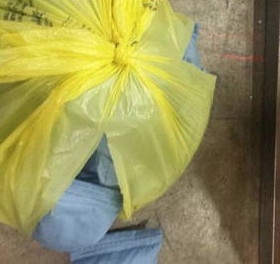 Cleanzine: your weekly cleaning and hygiene industry newsletter 18th April 2024 Issue no. 1110
Cleanzine: your weekly cleaning and hygiene industry newsletter 18th April 2024 Issue no. 1110
Your industry news - first
The original and best - for over 20 years!
We strongly recommend viewing Cleanzine full size in your web browser. Click our masthead above to visit our website version.
Soapbox: The shocking truth about clinical waste sacks
 By Lorcan Mekitarian, commercial director, bpi.healthcare
By Lorcan Mekitarian, commercial director, bpi.healthcare
As outrageous as it sounds, many of the clinical waste sacks being used by hospitals and other healthcare establishments in the UK are not compliant with the United Nations requirements for the Carriage of Dangerous Goods.
The United Nations have set universal standards governing the classification, packaging and labelling of dangerous goods, in order to ensure safe transportation and ultimately to protect people from infection by harmful diseases, including the potentially deadly Ebola virus.
In recent tests carried out at bpi.healthcare's UKAS approved laboratories, we found that many of the sacks we sampled failed the UN 'drop test' designed to ascertain whether they were strong enough to satisfy 'Carriage of Dangerous Goods' requirements.
This drop test, which was developed by the United Nations, specifies that six clinical waste sacks from a batch must be dropped three times each from a height of 1.2m - and survive intact - to ensure they meet the Carriage of Dangerous Goods standard.
In our tests, which were conducted on 13th August 2014, we discovered that many sacks did not pass the approved weight specified on the bag. As a result, these sacks suffered multiple tears when drop tested, allowing the contents to spill over the floor. In the case of one supplier, every one of the six waste sacks we assessed failed the drop test.
Our drop tests were conducted with inert material so that none of our staff were put at risk. But if a sack was to rip open in a hospital environment, for example, it would mean that highly infectious waste materials such as bandages contaminated with human blood and tissue could escape onto wards, public areas or even operating theatres. This would put patients, staff and members of the public at great risk of harmful infection.
One of the reasons why this is such an appalling prospect is that hospitals might, quite justifiably, believe they can trust their suppliers to provide them only with clinical waste sacks that are up to the job. In an advanced country like the UK, it seems completely unthinkable that lives could be endangered by something as simple as poor quality waste sacks. Indeed, we also have ample legislation in place to govern the disposal of clinical waste.
However, as our tests show, there is in fact poor compliance with these rules by some companies who are only too happy to put profits above people's wellbeing. Sub-standard products are slipping through the net, increasing the possibility that disease could be spread in an environment where many people are already in a vulnerable situation health-wise.
Mounting concern about the Ebola virus, throws this problem into sharp relief. This is not a question of poor quality sacks causing inconvenience to hospital cleaners. What we have here is shortcuts being taken in the manufacturing process which puts lives in danger.
This isn't the fault of the hospitals. At face value the sacks appear to be compliant and display the necessary labels. However, some companies are claiming their sacks comply with the Carriage of Dangerous Goods standards, when in fact they don't.
As a result, hospital staff are being duped into thinking that the clinical waste sacks they are using on a daily basis are strong, safe and up to the task they were purchased for. The truth is, they might not be.
So what can hospitals do about this? Understandably, they are not in a position to drop-test the clinical waste sacks they buy. The solution is simple: take nothing for granted and be vigilant. Hospitals shouldn't have to worry about their clinical waste sacks not being good enough. So they need to have confidence that their supplier is really selling what they claim to be.
At bpi.healthcare, we are keen to provide some way to reassure hospitals about the quality of their clinical waste sacks. We've worked with the Cleaning & Hygiene Suppliers Association in recent years to develop a plastic refuse sack standard for the cleaning & hygiene market. This is designed to offer customers in this sector a guarantee that they are not being cheated and confirms that the sacks they are buying meet all stated dimensions and are fit-for-purpose.
Unfortunately, there is currently no equivalent in the healthcare sector. It is a real blind spot, and one that we would very much like to see eradicated.
If a hospital has any doubt about the quality of its clinical waste sacks, BPI advises sending a sample to the HSE Head Office, addressed to CEMHD 4 at Redgrave Court, Merton Road, Bootle, Merseyside, L20 7HS. As the body responsible for enforcing compliance with the Carriage of Dangerous Goods legislation, they will be able to provide reassurance or - in the worst-case scenario - highlight any non-compliance.
bpi.recycled products is the largest recycler of used polythene in Europe recycling up to 70,000 tonnes of post-use polythene material from horticultural, commercial, retail, industrial and agricultural markets.
E: [email protected]
W: www.bpipoly.com
16th October 2014







